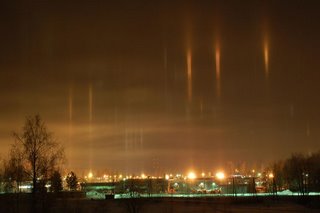 |
| © YUAN Quan, shown with permission. Equivalent focal length 39mm (from EXIF, unclear whether it's accurate). |
Shortly after YUAN’s photo went public, LI Yahong and HUANG Tengyu from the China Sky Enthusiasts community found out that the light pattern, when flipped and rotated, perfectly matches downtown Xiamen’s map.
 |
| YUAN Quan's photo flipped and rotated 180°. Map from Apple Maps. |
With the help of real night time images of Xiamen captured by Wuhan University’s Luojia-1A satellite (http://59.175.109.173:8888/index_en.html) and Chang Guang Satellite Technology's Jilin-1 satellite (https://mall.charmingglobe.com/Archive/), LI and HUANG’s finding was verified - we’re looking at a reflection of Xiamen’s city lights off the clouds.
*Special thanks to the Luojia-1A and Jilin-1 satellite teams for authorizing data usage.
 |
| Satellite images copyrighted to Jilin-1 and Luojia-1A satellite teams, shown with permission. |
This phenomenon is most likely a high cloud light pillar event, similar to a previous case in Finland (http://www.thehalovault.blogspot.com/2017/03/map-in-sky.html) but on a much larger scale. The reflection captured in YUAN’s photo corresponds to an area of 200 square kilometers on the map. What’s even more interesting, the ground temperature in Xiamen during the event was 23°C - a fairly warm night.
Due to the lack of background stars in YUAN and other people’s photos, it’s hard to do accurate cloud height calculations. A rough estimate by ZHANG Jiajie places the clouds between 6 and 7 kilometers above sea level. Sounding data from the night indicates the existence of a moist and wind-free layer in the 6 to 7 kilometer range so the height estimates may not be too far off.
Such warm night high cloud light pillar events are becoming more frequent in China - another two weaker ones were observed in the past few months in different cities. We believe the ubiquitous usage of decorative LED strips (which are very bright) on tall buildings, as well as the vast improvements in low-light photography on newer smartphones are two of the key factors leading to the surge in new observations.









